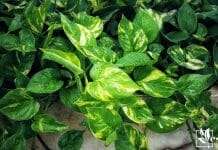Hostas, the lush foliage plants that are a staple in shade gardens, bring a serene and robust presence to any yard. From waxy greens to variegated patterns, these perennials have earned their popularity in diverse climates and landscapes. Despite their hardiness, gardeners often encounter a common problem: the yellowing of hosta leaves. This change in leaf color can be an indicator of several underlying issues, from natural life cycle processes to environmental stress factors.

If I notice the leaves of my hostas turning yellow, it’s crucial to address various aspects such as adequate shade, appropriate watering methods, and proper soil conditions to ensure the plants remain healthy and vibrant.
As a gardener, I understand the importance of ensuring that my hostas are planted in fertile, well-draining soil coupled with the right amount of moisture. These plants appreciate damp conditions, but excessively wet or poor-quality water can lead to problems such as root rot and fungal diseases. Hostas thrive in shade, and if exposed to too much direct sunlight, their leaves may scorch and yellow as a result. Optimizing these conditions helps in preventing the yellowing of the leaves, allowing hostas to flourish and enhance my garden’s beauty year after year.
JUMP TO TOPIC
Optimal Growing Conditions for Hostas
Creating the ideal environment for hostas involves balancing several factors to prevent yellowing and support their lush foliage.
Shade and Sunlight Requirements
Hostas thrive in partial shade to full shade. Prolonged exposure to direct sunlight can lead to yellow leaves, a condition known as ‘hosta scorch.’ Ideally, hostas should receive morning sun and be shielded from the intense afternoon sun, which can cause their leaves to yellow and wilt.
Soil Quality and Composition
Soil rich in organic matter with good drainage ensures healthy hosta plants. The soil should be able to retain moisture without becoming waterlogged. Achieving a soil pH that is slightly acidic to neutral is beneficial for nutrient uptake. Before planting, it’s wise to amend the soil with plenty of organic compost, which provides the essential nutrients hostas crave.
Watering Practices and Moisture Levels
Watering is crucial—too little water results in yellow leaves, while too much can cause root rot. Ensure the soil is moist but not saturated. Employing mulching can help maintain consistent moisture levels. I only water my own hostas when the top inch of the soil feels dry to the touch.
Temperature and Seasonal Changes
Hostas are tolerant of a range of temperatures but do best in moderate climates. They may experience stress during high heat which can manifest as yellowing leaves. During seasonal transitions, especially as autumn approaches, it’s natural for hosta leaves to turn yellow as they enter dormancy.
Extreme weather changes can also contribute to leaf yellowing, so it’s important to provide a stable growing environment.
Maintaining Healthy Hostas
To keep hostas vibrant and green, it’s essential to focus on four key areas: disease prevention, pest control, correct fertilization, and understanding environmental factors.
Preventing and Identifying Diseases
My hostas remain disease-free by ensuring proper air circulation and moisture control.
I lookout for signs of fungal diseases like petiole rot, which starts with yellowing leaves and progresses to a rot at the plant’s base. Enhancing drainage and avoiding overhead watering diminish this risk.
Managing Pests and Nematodes
- I use neem oil as a natural preventative measure.
- For immediate infestations, diatomaceous earth is my go-to solution.
- Sticky traps or copper tape can deter pests and protect the hostas.
The Importance of Proper Fertilization
Fertilizer is critical for maintaining healthy hostas. I always use a balanced fertilizer with essential nutrients like iron to prevent chlorosis, which can lead to yellowing leaves due to nutrient deficiency.
Addressing Environmental Stresses
Environment stressors can cause my hostas’ leaves to turn yellow. Insufficient water leads to dehydration stress, while overwatering may suffocate roots and cause rot. I ensure that my plants are in well-draining soil and I adjust watering to rainfall patterns and seasonal needs.
Pro tip: Mulching helps retain soil moisture and keeps roots cool.
Seasonal Care for Hostas
Each season brings unique challenges and opportunities for Hosta care. By understanding what these plants need during different times of the year, I ensure their health and prevent yellowing leaves.
Spring Revitalization and Mulching
Upon the arrival of spring, I witness the emergence of new growth from my Hostas. It’s a critical time to prevent overwatering and under-watering as these extremes can lead to stress and yellowing leaves. To help with this, I apply a generous layer of mulch; not only does it retain soil moisture but it also regulates temperature.
- Check soil moisture levels regularly
- Apply 2-3 inches of organic mulch around Hostas
Summer Upkeep and Overexposure Protection
Summer calls for diligence as heat stress and too much sun can cause Hostas to turn yellow. I make sure my plants are shaded during the peak hours of sunlight. If a heatwave is forecasted, I consider temporary shading solutions. Adequate watering early in the day helps my Hostas withstand the summer heat.
💥 Note: Choose a planting location that provides afternoon shade to shield the Hostas from extreme temperatures.
Autumn Preparations and Cleaning
With fall approaching, Hostas enter a phase of dormancy. This is the time to clear away any dead foliage to prevent diseases and pests. I also water them less frequently, as the plants require less moisture in cooler weather. Preparing them for dormancy is key to their return in spring.
Avoid fertilizing in late summer to early fall to prevent new growth that won’t survive the winter.
Winter Dormancy and Frost Management
During winter, I ensure my Hostas are well insulated. An additional layer of mulch after the first frost helps protect the crowns from freezing temperatures. I refrain from disturbing the plants during their dormancy period to ensure they can reemerge vigorously when the warmer days arrive.
| Phase | Action |
|---|---|
| Post-First Frost | Add extra mulch for insulation |
| Throughout Winter | Minimize soil disturbance |












